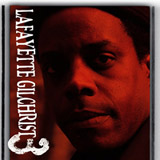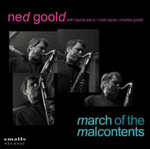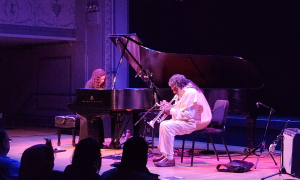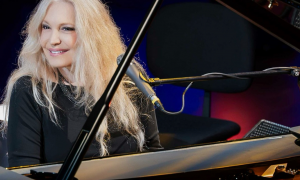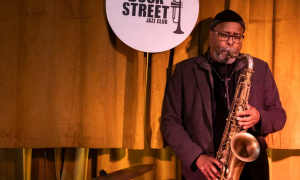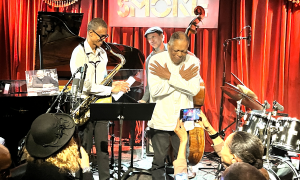Home » Jazz Articles » Live Review » Pete Cosey's Children of Agharta Play the Lower East Side
Pete Cosey's Children of Agharta Play the Lower East Side
When Cosey and Liebman re-imagined 'Black Satin' this night at Club Cave Canem to close their set, it morphed into something distinct from its original incarnation.
Cave Canem
New York, NY
June 21, 2007
Pete Cosey's Children Of Agharta channels the fusion music of the great Miles Davis band of the early to mid-1970s. They go down many of the same roads blazed by the Davis group of that era when, in fact, Cosey filled the lead guitar chair. Yet simply comparing Cosey's band to the Dark Magus band does not give Children of Agharta its due credit-even if Miles Davis' shadow was particularly long the night of June 21st, when Children of Agharta was in the groove at Club Cave Canem on the Lower East Side. During the performance, Cosey covered two of Davis' songs, Dave Liebman, another member of the Dark Magus band, stopped by, and earlier in the day Liebman and Cosey had recorded an interview and performed together at Davis' old digs on West 77th street.
But Cosey is his own man and had already earned quite a pedigree by the time he joined up with the Man With the Horn in the 70s. Miles Davis hired Cosey to complement his new and increasingly avant-garde band of the mid-70s, to help him infuse his music with raw rock energy, to 'comp behind his musings on wah wah trumpet and organ. Having already played on some of the choicest Chess Records sides of the 60s, helped found Earth, Wind, and Fire, as well as the Association for the Advancement of Creative Musicians, Cosey augmented Davis' new rock inspired directions. Cosey (and Liebman) were central in shaping that hard funk sound with its metallic edge that increasingly characterized Miles Davis' music as the 70s wore on. Even after Davis' change in musical direction during the 80s and after his passing fifteen years ago, still Cosey has not stopped exploring the sound he and the Dark Magus band put together.
When Cosey and Liebman re-imagined "Black Satin" this night at Club Cave Canem to close their set, it morphed into something distinct from its original incarnation. They concentrated more on the rhythm that simmers underneath that famous refrain, centering their explorations around the bass and guitar groove, wringing every last drop out of it, and restraining themselves from launching into the motif that makes "Black Satin" so instantly recognizable. They distilled an essence from the tune easy to miss behind the wah wah, whistling, and hand-clapping motif that jumped off the original wax and made it so, well, distinctive. This is what makes the band so special. They concentrate on building the core, but never become lazily groove- oriented; they manage to keep a raw and even metallic edge that so many groove projects miss. This core is complex, funky, and constantly morphing around the tight pairing of bassist Melvin Gibbs and drummer JT Lewis.
Children of Agharta is not content to create sprawling canvases of sound around that raw core with conventional instruments. The wide assortment of noise-makers, drums, and electronic gizmoetry that Cosey brings to the stage with him tips off his audience to ambitions beyond simply playing blistering guitar. Cosey's imagination transcends the limits imposed by more standard setups and ensembles: he shapes a particular soundscape, heavily reliant on a wide assortment of musical unorthodoxies to bend the sound waves to his will. With his band he has found a set of kindred spirits; a particular highlight of the band is the seamless integration of Johnny Rosado (DJ Juice) into the sound.
With Rosado, "So What," a 1959 song that often lends itself to hoary, sterile versions, came off without a hitch that evening, reminding us why the song became a standard in the first place. Another standout moment came when the band reworked Willie Dixon's "Seventh Son"-this time led by Pete Cosey thunking out the rhythm on Sansa, or African thumb piano. Innovation, not simply novelty, defines Mr. Cosey's work.
The evening felt good, complemented by the geniality and cordiality of Mr. Cosey as well a sort of seedy coziness that characterized the Cave Canem, a place where bohemians, transgenders, and music fans alike might feel welcome. This is the kind of Lower East Side joint that comes to us unaltered from the turn of the last century, the kind of place where a wrong turn on the way to the john might land you in a peepshow, or where they feature taxi dancing on off nights. Adding to the irie feeling of the place was the lackadaisical pace of the band, management, and even the friends that filled the audience in that little cellar room. The 9:30 showtime ended up as more of a suggestion than some kind of hard and fast ultimatum. We had an extra hour to enjoy the selector as the little cellar room slowly filled up. Cosey and company certainly did not rush to get on with the show. Plastic Rite Aid bags full of gear and pedals remained unpacked and unplugged until at least a half an hour after the scheduled showtime. Nor, when Mr. Cosey was ready to begin was the selector quick to pass the mic or his bandmates anywhere to be found.
Cosey opened with an ode to the "People of the Sun" in which he, invoking a style reminiscent of that great wave of spiritual jazz that filled up the last few years of the sixties, laid down some space-age lyrics while beating and squeezing on a stringed diaphragm drum. Next, when the band launched into "So What" Cosey did not fail to disappoint on guitar. When he led on guitar, he screamed out lines that belied the deliberate pace in which Mr. Cosey speaks and presumably lives. It wasn't just the lead work that made his guitar craft so outstanding: gushes of warm delay snaked around his lines, produced by and feeding back through the vast assortment of electronics arrayed at his fingers and feet. Melodies we thought evaporated into the stale air filling that cellar on the Lower East Side would, like phantasms, return from out of the ether, beacons escaping the limbo between Mr. Cosey's amp and Club Cave Canem's sound board.
His comping also warranted remark; Cosey's warm eleventh chords cushioning Dave Liebman's jagged flights on soprano saxophone lent the soloist an ample landing pad. And on top of this guitar, DJ Juice fit right in. Sometimes we did not even notice the DJ-he simply faded into the sound canvas, something remarkable for such a novel jazz instrument to achieve. His scratches waned in and out, weaving around the nadirs and peaks coming from Cosy's guitar, never interfering, always in a supportive role.
The band may not be to everyone's liking; it's sort of the anti-Marsalis. To appreciate this sort of music requires expanding the concept of what makes an instrumentalist musical: it's about chops, but there's less room for the individual, it's more communal. For this band, it wasn't just the technical prowess of Melvin Gibbs pushing out dub-infused bass lines, or Rosado's masterful turntablism, or Lewis' understated drums that made the band so special. It was also the way they interacted with feedback and scratches sculpted into faint birdcalls and echoes hovering somewhere above the stage. There was no sampling going on onstage, but the sound gestured towards the sort of thing the best hip-hop producers put together. In fact, the band closed with an encore pulled from Public Enemy's It Takes a Nation of Millions.
Children of Agharta is the sound of pushing on with creative music-making and casting away preconceived ideas and reservations about what jazz is supposed to sound like. In that way they really do continue with Miles Davis' life work. Unfortunately, that sort of project has fallen on hard times these days. With the difficulty that less traditional jazz has finding a stage in the ever higher rent Manhattan clubs, perhaps there is a little more room for adventure in Mr. Cosey's hometown of (as he pronounced it) Chicaahgey.
Tags
PREVIOUS / NEXT
Support All About Jazz
 All About Jazz has been a pillar of jazz since 1995, championing it as an art form and, more importantly, supporting the musicians who make it. Our enduring commitment has made "AAJ" one of the most culturally important websites of its kind, read by hundreds of thousands of fans, musicians and industry figures every month.
All About Jazz has been a pillar of jazz since 1995, championing it as an art form and, more importantly, supporting the musicians who make it. Our enduring commitment has made "AAJ" one of the most culturally important websites of its kind, read by hundreds of thousands of fans, musicians and industry figures every month.


